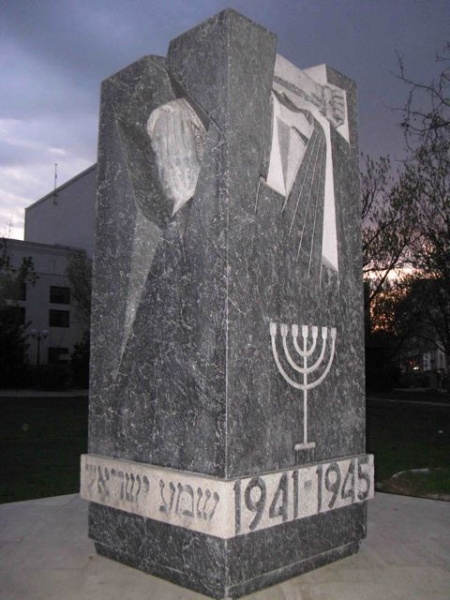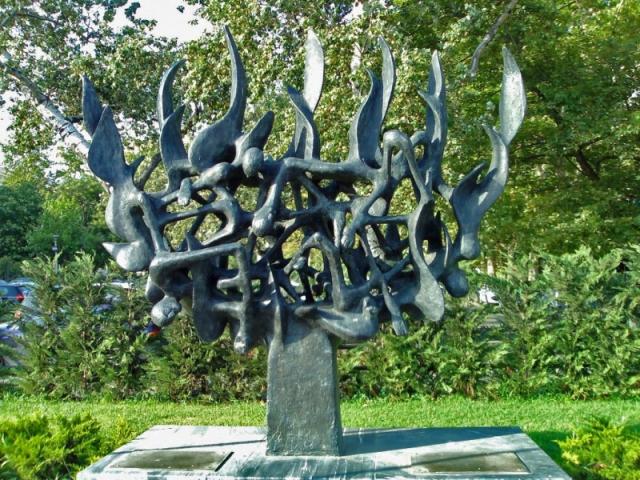- The memory of the Holocaust began to be impressed upon the collective memory of the West and internationally in the 1980s, with Auschwitz becoming the metonym for genocide. The survivors have begun writing about the Holocaust en masse since the 1980s. When was the moment for the verbal expression of these painful memories ripe in Greece, when was the first evidence of surviving Greek Jews published and which are the most typical among them?
 - The first evidence, that by Heinz Kounio "A Litre of Soup and Sixty Grams of Bread: The Diary of Prisoner Number 109565" was published in Thessaloniki in 1982, then Pavlos Simha published "The Dimitriou Family" (Thessaloniki, 1988). A literary magazine in Athens published a memoir text by Sam Profeta "Thessaloniki-Auschwitz". At the end of the decade, Berry Nachmia’s testimony "A Cry for Tomorrow" was published in Athens, which has a multi-dimensional significance. The 1990s witnessed a "boom" of interest in this subject in Greece. Here I must mention the work by authors Errica Kounio-Amarilio and Albertos Nar Oral Testimonies of Thessaloniki Jews on the Holocaust, edited by professor at Thessaloniki University Frangiski Abadzopoulou (Thessaloniki 1998). Also the book by Errica Kounio-Amarilio 50 Years Later – Memories of a Thessaloniki Jewess, again edited by Abadzopoulou. The book has been translated into English, French, German and other languages. I want to emphasize the importance of translation. A Greek testimony "speaks out" in European languages, reminding the West of the fact that the Nazi persecutions were not confined to Central and Eastern Europe but reached the Aegean coast and our sun-bathed islands and ports. I am mentioning this because foreign publications, museums and congresses that claim to provide a comprehensive look at the genocide of Jews often forget or underestimate this fact. This means that the case of Greece is often totally absent or its mention is totally disproportionate to the scale of the persecution as just a few words present the experience of Thessaloniki. I believe that this "silence", another silence oppressing the genocide of Jews, is associated with the Sephardic origin of the majority of them. In the minds of Jews in the West, the Holocaust is too often considered as a case of Central and Eastern Europe. Poland, Hungary, Germany, Czechoslovakia, Austria undoubtedly are the countries that paid the heaviest blood tax. Concerning Ashkenazi Jews, Yiddish being their common language, the genocide is often considered a phenomenon relating to them alone. This is the reason for the importance of the translation of the Greek Jewish testimony.
- The first evidence, that by Heinz Kounio "A Litre of Soup and Sixty Grams of Bread: The Diary of Prisoner Number 109565" was published in Thessaloniki in 1982, then Pavlos Simha published "The Dimitriou Family" (Thessaloniki, 1988). A literary magazine in Athens published a memoir text by Sam Profeta "Thessaloniki-Auschwitz". At the end of the decade, Berry Nachmia’s testimony "A Cry for Tomorrow" was published in Athens, which has a multi-dimensional significance. The 1990s witnessed a "boom" of interest in this subject in Greece. Here I must mention the work by authors Errica Kounio-Amarilio and Albertos Nar Oral Testimonies of Thessaloniki Jews on the Holocaust, edited by professor at Thessaloniki University Frangiski Abadzopoulou (Thessaloniki 1998). Also the book by Errica Kounio-Amarilio 50 Years Later – Memories of a Thessaloniki Jewess, again edited by Abadzopoulou. The book has been translated into English, French, German and other languages. I want to emphasize the importance of translation. A Greek testimony "speaks out" in European languages, reminding the West of the fact that the Nazi persecutions were not confined to Central and Eastern Europe but reached the Aegean coast and our sun-bathed islands and ports. I am mentioning this because foreign publications, museums and congresses that claim to provide a comprehensive look at the genocide of Jews often forget or underestimate this fact. This means that the case of Greece is often totally absent or its mention is totally disproportionate to the scale of the persecution as just a few words present the experience of Thessaloniki. I believe that this "silence", another silence oppressing the genocide of Jews, is associated with the Sephardic origin of the majority of them. In the minds of Jews in the West, the Holocaust is too often considered as a case of Central and Eastern Europe. Poland, Hungary, Germany, Czechoslovakia, Austria undoubtedly are the countries that paid the heaviest blood tax. Concerning Ashkenazi Jews, Yiddish being their common language, the genocide is often considered a phenomenon relating to them alone. This is the reason for the importance of the translation of the Greek Jewish testimony.
In 1994, a special edition of Synchrona themata magazine was devoted to the issue, and important books were translated in the following years, including Salonica, City of Ghosts: Christians, Muslims and Jews 1430-1950 by Mark Mazower (published by Alexandria, Athens 2007) and Crown and Swastika. Greece during the Occupation and Resistance 1941–1944 by Hagen Fleischer (published by Papazisis, 1995), containing chapters on the Holocaust of Greek Jews. Thus, around 1995, a bibliography first began to form.
- How would you respond to those who believe that "The Diary of Anne Frank" is a literary mystification and that the genocide of Jews never existed, nor did its symbolic tool, the gas chambers?

- It must be emphasized from the outset that there can only be different interpretations in terms of the issue of genocide, without insinuations about the fact itself. There is no room for "views and opinions", the fact itself is not subject to discussions, this just happened. Nevertheless, during the 1980s which were favourable yeas for the revival of racism in Western Europe in parallel with the collapse of memory regarding the Holocaust, untenable theories were born that denied the existence of extermination camps and hence the implementation of the genocide of the Jews. This was the decade the end of which would be marked by the collapse of real socialism, mass emigration and a revival of nationalisms. All of these events would contribute towards the adoption of such theories. The fact that all that was dressed in the form of scientific views that were spread like well-established scientific knowledge (publications, lectures, conferences, etc.) spreads turned out to be even more dangerous. Later, in the 1990s and even in the first decade of the 21st century, the uncontrolled possibilities offered by the Internet provided the opportunity for even greater dissemination of these lies.
This course, which was initially characterized as revisionist and later as negativism, in Germany took the form of the famous dispute between historians, called Historikerstreit. Unfortunately, an established historian by the time, namely Ernst Nolte, became the leader of the German "revisionists". By the way, Nolte denied this special feature of the genocide and implied that the victims and the executioners were equally responsible. He also argued that the Nazis had copied their practices from the Communist Party of the Soviet Union and therefore Nazism was simply the necessary response to communism. Finally, he argued that the only innovation of this genocide was the invention of the gas chambers.